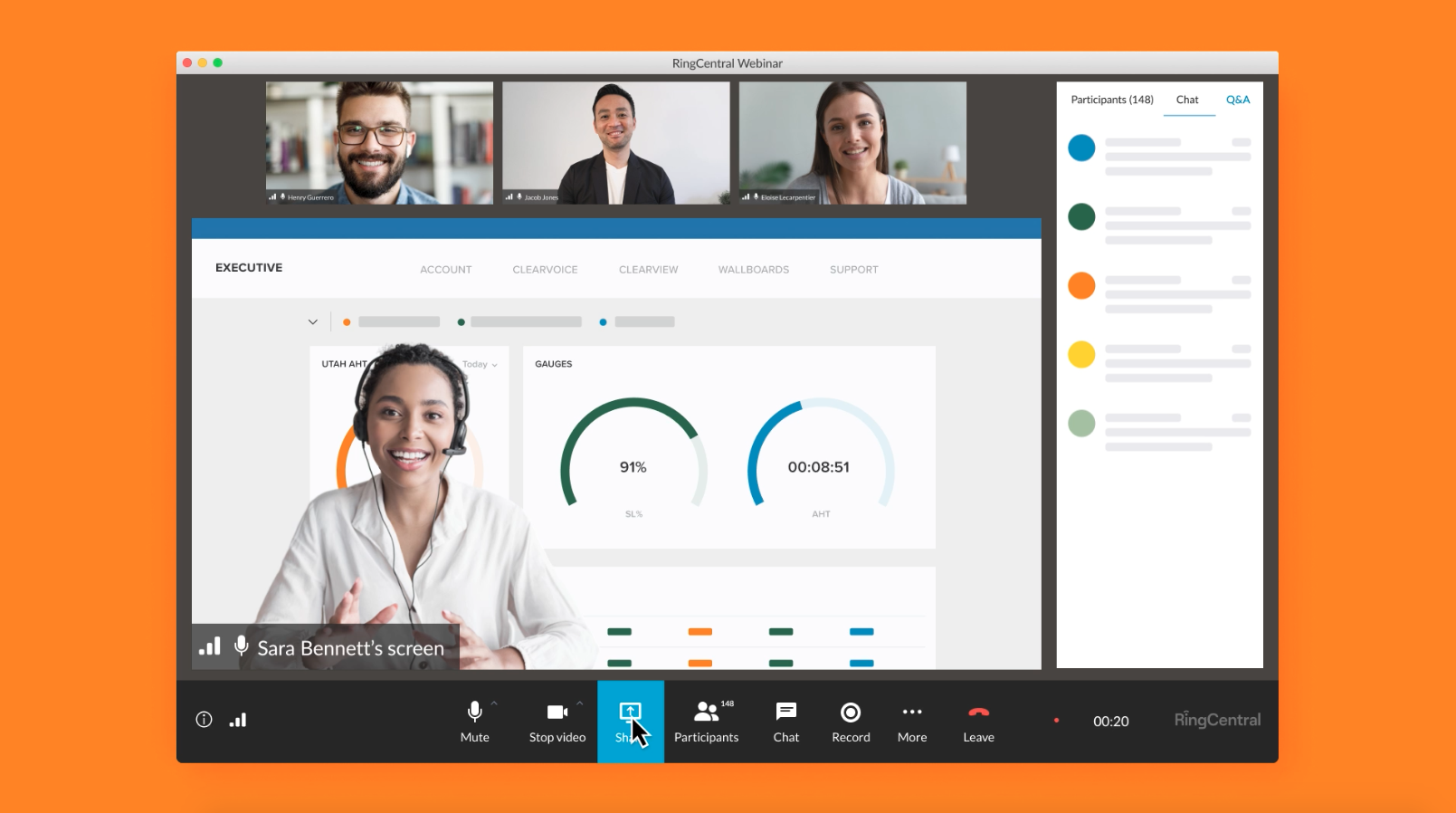Hopin is now RingCentral Events
Virtual events were on the rise pre-pandemic, acted as a lifeline in 2020, and have now become a staple of almost every event strategy due to their proven business impact.
More than 70% of event planners say a digital component will continue to be a key part of their approach.
In this guide you’ll find a broad introduction to the concept of virtual events, the advantages they offer, frequently asked questions about the virtual event format, and inspiration and tips so you can start planning.
Here are the topics we’ll cover:
Virtual event ideas and examples
Video conferencing tools vs. virtual event platforms
What is a virtual event?
A virtual event is any gathering that takes place online instead of in person. It can apply to a broad spectrum of experiences, from your weekly book club or company meeting to large-scale conferences and trade shows.
Online events don’t have to completely replace a physical event. You can also add virtual elements to any in-person experience to create a hybrid event, which blends the online and onsite experiences so attendees can participate from anywhere––and event organizers get the best of both worlds.
Benefits of virtual events
While physical events come with face-to-face interaction and that in-person energy, online events (or adding a virtual component to your physical event) offer increased reach and accessibility. Using a dedicated virtual event platform with interactive elements, promotional tools, and networking features also provides a venue for plenty of connection and engagement.
One of the unique advantages of bringing the event experience online is the ability to provide more value at a lower cost, driving a better experience for attendees, speakers, and sponsors––and a boost in ROI for organizers.
Some of the key benefits of virtual events include:
1. Wider reach
Removing the restrictions that come with hosting an in-person event at a single venue allows you to scale.
With a virtual or hybrid event you can reach, accommodate, and engage a much larger, geographically distributed audience.
Providing an online experience also means costly travel arrangements and extended time off are no longer factors, so participation immediately becomes possible for more people.
This increase in scale improves the value of your event through:
- Better monetization like options for online ticket sales and more sponsorship revenue opportunities, as well as cost savings on a physical venue––all of which helps to increase your ROI.
- Simplified lead generation and access to more data, allowing you to easily demonstrate sponsor reach from virtual events with straightforward tracking on attendee touchpoints.
Once you scale your event through digital channels, it’s also easier to replicate your approach without dramatically increasing your efforts. This gives you the opportunity to iterate and improve each of your virtual events, increasing efficiency and effectiveness.
2. Cost-savings
A significant advantage of hosting a virtual event instead of a traditional onsite event is cost-efficiency. There’s generally a lower cost associated with organizing and hosting an online gathering––and it’s not purely monetary.
Virtual events cost less time, money, and effort than in-person events.
First, they don’t require spending on physical resources. There’s no onsite venue to book, permits to secure, or catering and hospitality expenses.
Online events are also more cost-effective for attendees. Participants don’t have travel budgets to consider, accommodation costs, or potential loss of income from multiple days away from work.
This cost-efficiency has benefits that go beyond budgets, such as:
- Opportunities for more events: In-person events can be impractical, costly, or challenging to plan, but virtual events break down these barriers allowing you to bring people together more often.
- Increased ROI potential: With the scalability of digital events, you can dramatically increase audience size without an equivalent increase in cost. There are lower marginal costs per additional attendee, which helps boost your potential event ROI.
- More flexible budgets: Hosting virtual events gives you bandwidth to repurpose budgets you may have previously allocated on venue space or other physical resources. Instead, funds can be shifted to things like building compelling programming, whether that means in-demand speakers, more presenters, innovative event content, or all of the above.
3. Broad participation
When you host an onsite event, barriers like budget, time, and ability limit participation to attendees and speakers who can travel to your physical venue. Beyond these considerations, in-person events also require more stringent commitments that people may not be able to accommodate.
Virtual events help remove those barriers, giving participants more flexibility, and allowing presenters and attendees to join from different parts of the world.
Offering virtual attendance:
- Allows for diverse perspectives: Participants from all over the world can now contribute to the conversation, and that means an improved event program featuring a variety of ideas and a wider knowledge base.
- Democratizes access beyond certain geographies: Many people have to limit in-person event attendance to nearby options or only go to a small number of events per year. Online events provide attendance opportunities with less budgetary impact or travel inconveniences.
- Provides convenience and flexibility: Because attendees can log in from almost anywhere, they are more likely to have the time and resources to participate in an event with a virtual format.
- Offers accessibility and inclusion: Digital participation means those with physical or health considerations can attend your event and engage with and enrich the program.
One of the reasons attendees find value in events is the opportunity to hear from and interact with industry experts, thought leaders, and notable personalities. With a virtual event, the pool of potential speakers and panelists expands.
Online speaking opportunities are easier from a scheduling standpoint, so high-profile speakers are more likely to participate. Plus, there are no travel or accommodation costs for the speaker or the business, which leaves more budget for top-tier presenters’ speaker rates.
4. Easy access to analytics and data
Hosting a virtual event provides easy access to data. With physical events, tracking what your attendees are doing and how they’re interacting with different elements of your event can be tricky.
Virtual event platforms offer valuable insights into how your audience responds to your event program—what expo booths are getting the most traffic, which content is resonating with attendees, as well as how participants are engaging with presenters and one another.
These analytics can provide:
- A look into how your event content performs: Knowing how attendees are interacting with your content can help optimize your program in the future.
- Trackable attendee touchpoints for post-event communications and community building
- More accurate data for calculating event ROI
These insights can help you learn more about your target audience and inform both marketing efforts and business strategy.
5. Simple content generation and community building
Another advantage of hosting an event on a virtual event platform is the ability to extend the life of your digital event content.
During your event, you can record all of your programming––from panels to top-tier speaker presentations. That gives you the option of repackaging event video content for new organic and paid activities across your marketing channels.
This content can be used to drive awareness of and engagement with your brand and products, and it can help generate leads. For example, you can make your videos watchable behind an email gate.
Registration lists and other event data can also help you build and foster an online community to grow your brand-audience relationships.
Email lists will give you the option of sending follow-up messages. From there, you can reconnect with attendees and guide them to places where they can continue their conversations, such as social media channels or other events. Email lists are also an effective way to share content captured during your event.
6. Sustainability
Onsite events generate waste and carbon dioxide emissions. Shifting to virtual events can lead to a much smaller environmental footprint.
Online events are more sustainable because:
- They do not require a physical venue: By going virtual, event organizers can reduce power consumption and minimize waste.
- They do not require attendees to travel, which dramatically reduces the collective carbon footprint of an event.
Virtual event FAQs
Virtual events bring people together, whether it’s to help teams work, speakers to speak, companies to grow, or just people to build relationships—all through the power of the internet.
Below, we answer the most-asked questions about hosting a successful virtual event.
1. How do you create a virtual event?
To host a virtual event, you will need to start with an online platform — there are many options, from video conferencing tools, to webinar software, to virtual meeting rooms, to full-conference virtual event platforms. Whether you’re looking to go completely virtual or take a hybrid approach, using an all-in-one event platform like RingCentral Events makes it easier to produce a high-quality experience for attendees with features such as a virtual lobby, online agenda, interactive content, expo booths, live broadcasts, and one-on-one networking.
Once you choose an event platform, it’s time to reach out to speakers and sponsors, and start planning. You can create your presentations, plan interactive moments, pre-record some video content, and determine how to promote your virtual event to increase registrations.
Learn more about how to host a virtual event like a webinar.
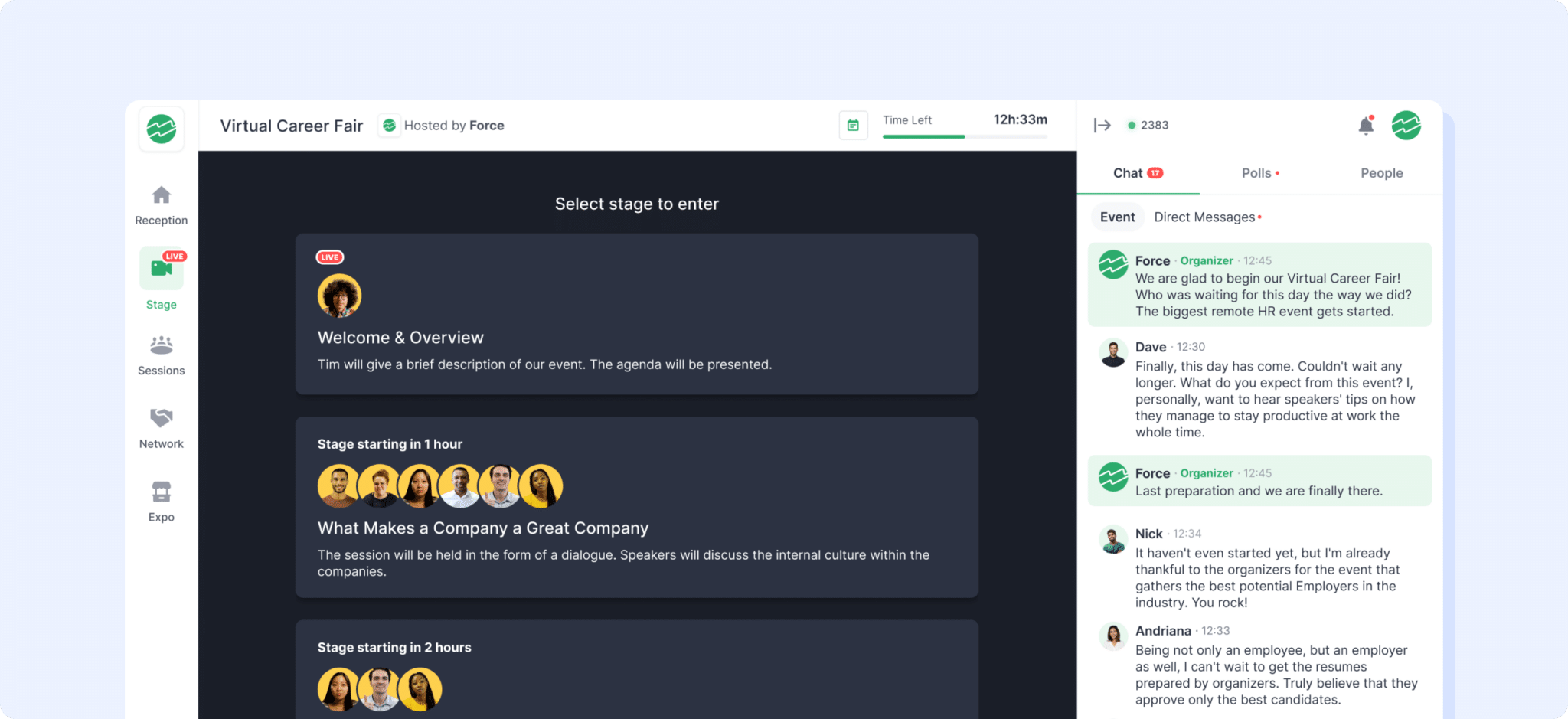
2. How long should a virtual event be?
The short answer is––it depends on your event. Is it a conference? Trade show? Meetup? Workshop? Fitness event? Entertainment performance? There’s no right answer.
Fun fact: The average length of a RingCentral Events event is 31.7 hours, but remember, your event can be any length.
One reason the average length of a RingCentral Events event extends beyond 24 hours is that when you host a virtual event, you open up your potential audience to the entire globe, meaning people all over the world can register. So, a 4-6 hour event on the ground may end up being in the range of 24 hours or more because more people are attending from different time zones.
Keep this in mind as you serve an international audience. Don’t hesitate to schedule pre-recorded content to stream live during your local off-hours. Also, there’s no need to worry about any technical difficulties on RingCentral Events as our support team is available 24/7 with global coverage.
Finally, when creating your event schedule, don’t forget to leave time in between keynotes and main sessions for interactive content like networking, polls, booths, and live Q&As that help attendees feel more connected to the content.
For example, if your networking timer is set to three minutes, you may want to build 5-6 minutes in between speaker segments to give attendees a chance to network and meet 1-2 people.

3. How does a virtual conference work?
A virtual conference can use the same format as an in-person conference minus the physical space, travel, food, and other cost barriers and inconveniences.
The event can include large keynote presentations, smaller break-out groups, panel discussions, networking opportunities, training, games—the possibilities are essentially endless depending on the platform you use.
With RingCentral Events, we’ve seen people do all sorts of amazing things at events, including get hired, watch football, and perform DJ dance routines.
The major difference between a virtual conference and a physical conference is that attendees log in via a virtual event platform on their phone (often through an event app), computer, or tablet. This makes the event more inclusive, accessible, and valuable.
In other words, hosting a virtual conference can expand your audience while allowing you to provide the same conference experience, just in a virtual setting. And using a virtual event software doesn’t mean you can’t replicate in-person events — we’ve seen many companies do it well, including Figma, The Wall Street Journal, United Nations, the NY Jets, and more.
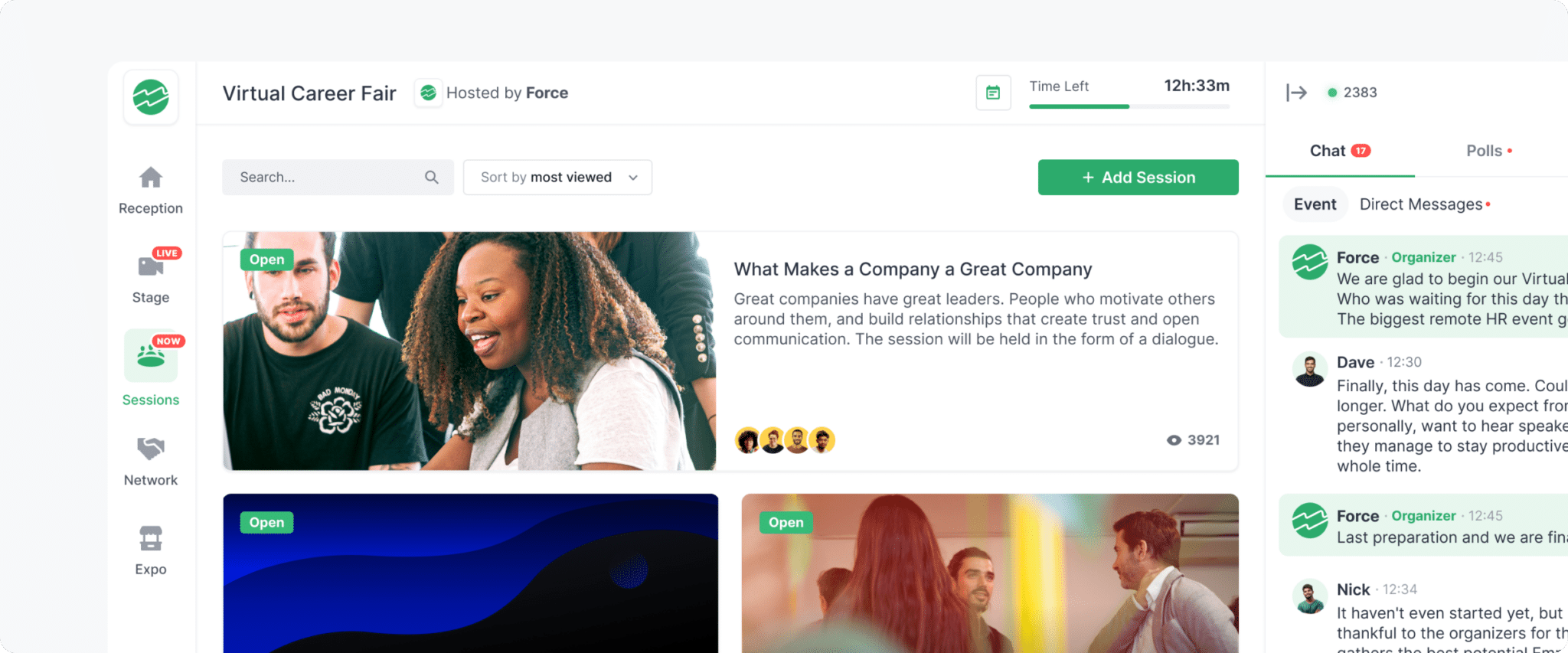
4. How much should you charge for a virtual event?
Pricing is different for everyone. It largely depends on a number of elements, such as your goals, audience, industry, speakers, event format, and so on.
Typically, there are three options for pricing your virtual event:
- Make it fully free to attend: This is great for reaching large audiences, which helps with lead generation, sponsor value, and adding to the top of your marketing funnel.
- Charge for tickets: Paid virtual events can be major money-makers, especially if your event has personal networking, creative interaction, and high-value speakers. Learn how one RingCentral Events event generated more than $150,000 in ticket sales. Fun fact: The average ticket price for virtual events hosted on RingCentral Events to date is $35.37.
- A combination of both: Most often, we see event organizers offer both free and paid tickets for their virtual events. This not only makes your event more flexible and accessible but it also supercharges your earning potential, allowing you to tap into both ticket revenue and sponsor revenue. For example, one organizer made $220,000 from sponsor revenue and another six-figures in ticket revenue.
Remember, every event is different and your pricing should match the experience and value you’re providing at your event.
5. How do you keep attendees engaged at a virtual event?
The best way to keep attendees engaged at a virtual event is by letting them meet one another. At RingCentral Events, we believe people are the most interesting part of an event. So we make it easy for people to discover new connections at every event hosted on our platform.
To connect people, leverage interactive features such as polls, two-way Q&A sessions, group chats, gamification, interactive demos, sponsor giveaways, watch parties, and more. These features help attendees meet one another and contribute to the experience, while also keeping easy online distractions at bay.
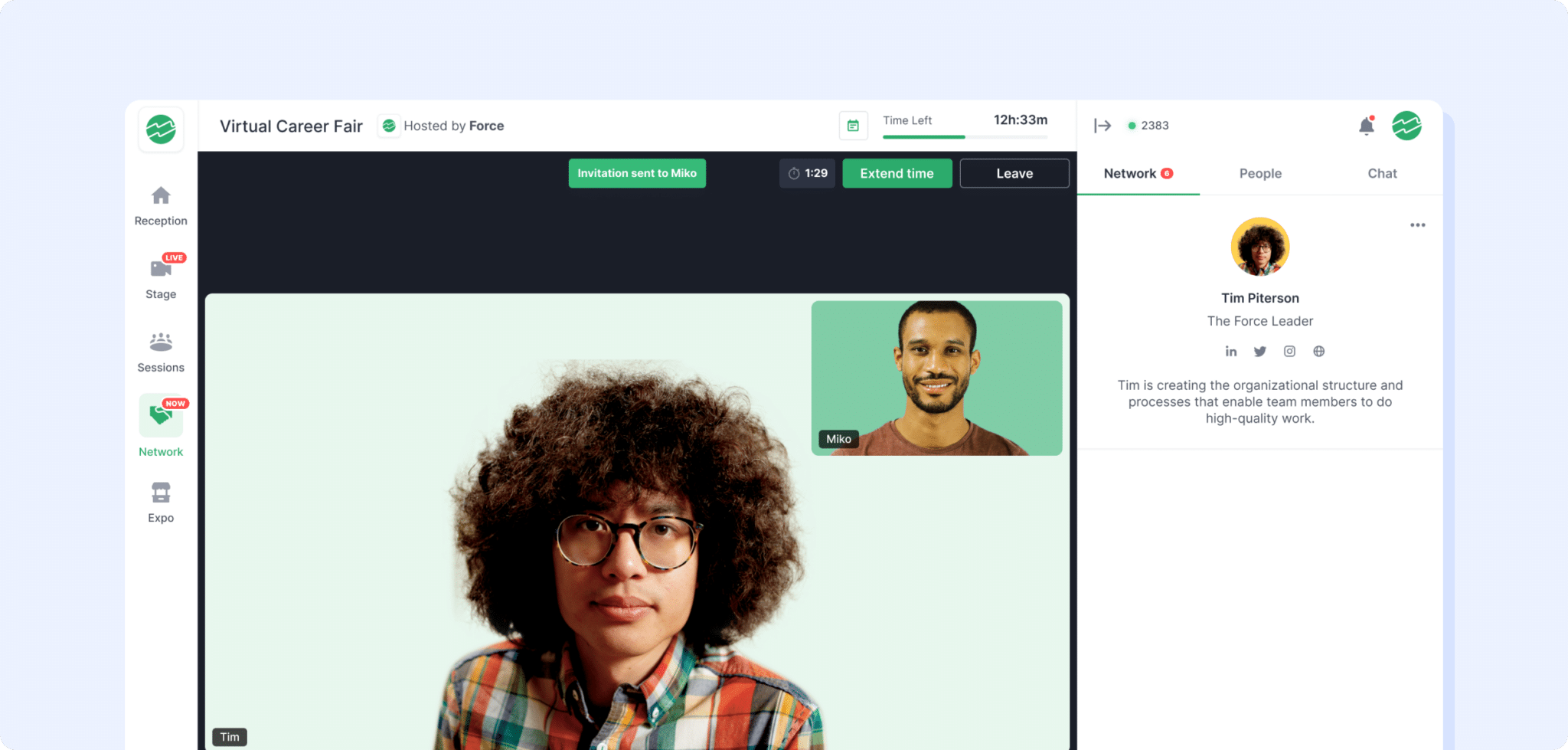
6. What happens after a virtual event?
You’ll want to capitalize on the momentum of your event experience and extend its lifetime value after it’s over. You can also collect learnings from the virtual event and use them to inform your strategy going forward.
Post-event, it’s best practice to:
- Follow up with attendees: Share event content, additional resources, videos, and session synopses. Ask for feedback with polls or surveys and create a call to action for future engagement.
- Review analytics: Dive into what worked and what didn’t, and try to find areas for improvement. Use this information to optimize future events and other initiatives such as marketing, recruitment, and lead generation.
- Repurpose content: Use the assets created for and during the event to post on organic and paid social media channels and to repurpose for other content channels and sales initiatives.
Virtual event ideas and examples
Plenty of companies and organizations have been holding remote workshops, conferences, and webinars for years. However, as in-person gatherings have become more challenging to host––if not impossible, at times––virtual events have grown tremendously in popularity and value.
Some virtual event examples include:
Marketing
- Virtual conferences and summits
- Festivals
- Competitions and award shows
- Expos and virtual trade shows
- Webinars
Internal communications
- Online training and workshops
- Sales kickoffs
Recruiting
- Virtual career fairs and virtual hiring events
Nonprofits and education
- Galas and fundraising events
- Classes
- Student Orientation
- Commencements and graduations
Social gatherings
- Weddings and other milestone celebrations
- Social club meetings and community events
- Health events and workout classes
- Entertainment
In many cases, virtual events can be better, more affordable, and generate more insights than physical events. They allow you to carefully track metrics, such as which sessions were the most popular, and gather more behavioral information about attendees. That information can be critical to planning your next event or marketing your products and services.
Let’s look at seven virtual event ideas and some real-life examples as inspiration:
1. Create a virtual event series
When the pandemic hit, The Next Web was forced to postpone its popular annual conference, TNW2020. After brainstorming about how to move the event online successfully, they decided to host a series of events called “Couch Conferences.”
Each event focused on a specific technology topic, such as digital marketing or how retailers use technology. Using RingCentral Events, they hosted a total of nine events with an incredible 276 speakers over 78 sessions.
The results were impressive. Throughout their virtual conference series, TNW had more than 20,000 attendees and delivered more than 35 hours of quality, online conference content.
In the end, TNW culminated its series by hosting the grand finale as their annual conference TNW2020 on RingCentral Events, where tens of thousands of people showed up, including some of the world’s biggest brands such as Google, Facebook, Spotify, IBM, Snap inc., and 200+ more to share their expert insights on what’s next in technology.
2. Provide networking opportunities
Networking is one of the biggest benefits of attending in-person conferences and events. At almost any event, there are plenty of chances to talk to other attendees while you wait for a session to start or when you’re in line to grab lunch.
Translating networking opportunities to a virtual event requires even less effort—with even more benefits.
At TechCrunch Disrupt 2020, the renowned CrunchMatch networking experience took place on RingCentral Events, where thousands of attendees, startups, investors, and more met over one-on-one live video inside the Disrupt event on RingCentral Events — no need to create separate meetings outside the event. This enabled the event to have a seamless, high-quality networking capability.
3. Offer on-demand content
Building an interactive online experience is critical to any virtual event’s success, and GitLab knocked it out of the park with its interactive, company-wide event Contribute 2020. As the largest all-remote company globally, GitLab understands the importance of in-person events to help remote teams bond.
In fact, they hold an annual in-person event every year to bring their whole team together. Then, of course, COVID happened.
The planning team had to pivot to an online format, but they weren’t sure how to get the same networking and bonding experience online.
Using RingCentral Events, they were able to host a live 1,200-person event spread out over multiple days (to account for time zones). The program involved two keynotes, several workshops, D&I roundtable discussions, and a final themed party with costumes encouraged.
Using features like live presentations from the leadership team, an awards ceremony, live polls, and Q&A sessions, they were able to keep their entire team engaged and excited—even though they were thousands of miles apart.
To get the most out of their content, GitLab used the recordings from RingCentral Events of the first half of their event to play on-demand in the Expo area. This format worked well for making information accessible to all attendees no matter where teammates were based.
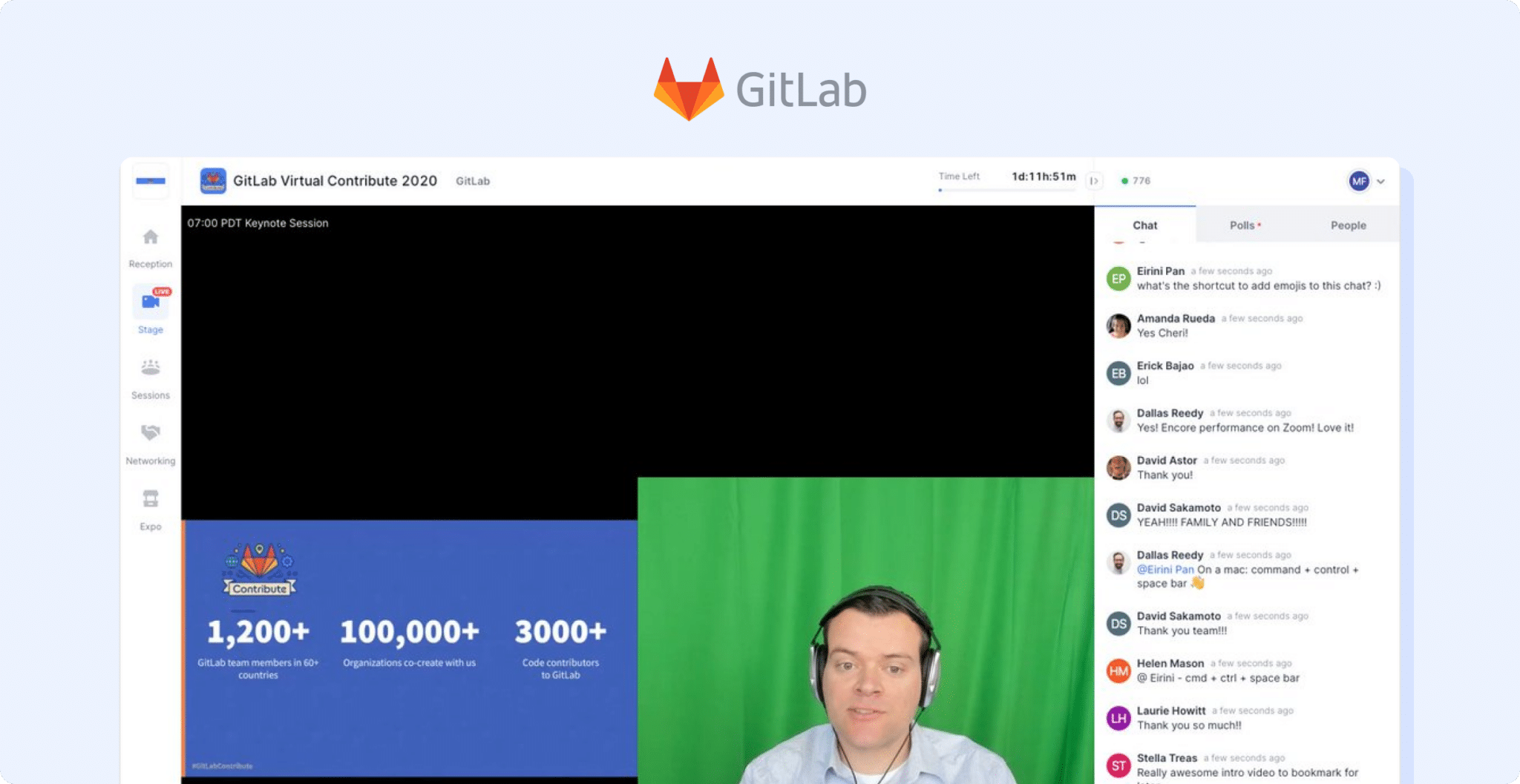
4. Host weekly events
Many virtual events are one-off events such as a conference, training for a new feature, or even announcing a new product. However, there is a lot of value in hosting weekly online events and internal meetings.
If you build in various modes of personal interaction and “movement” inside your event, attendees can meaningfully connect with fellow co-workers, prospects, customers, or just other industry professionals.
The Culinary Institute of America hosted a five-week event series called the Global Plant-Forward Culinary Summit.
A highlight of the attendee experience was the ability to view culinary demonstrations from chefs around the world bringing their kitchens to the screen, along with some live dialogue and Q&A with the chef on stage.
Weekly events can also be standing and used to provide customer or developer support, offer mentorships, or just meet for coffee and chat with other industry professionals.
These events can be casual; they don’t even need a fancy agenda. One way to do this with RingCentral Events is to leave out the Stage and Expo areas and just publish an event with Sessions and Networking. This creates a more intimate environment that is ideal for cross-team communication and team-building.
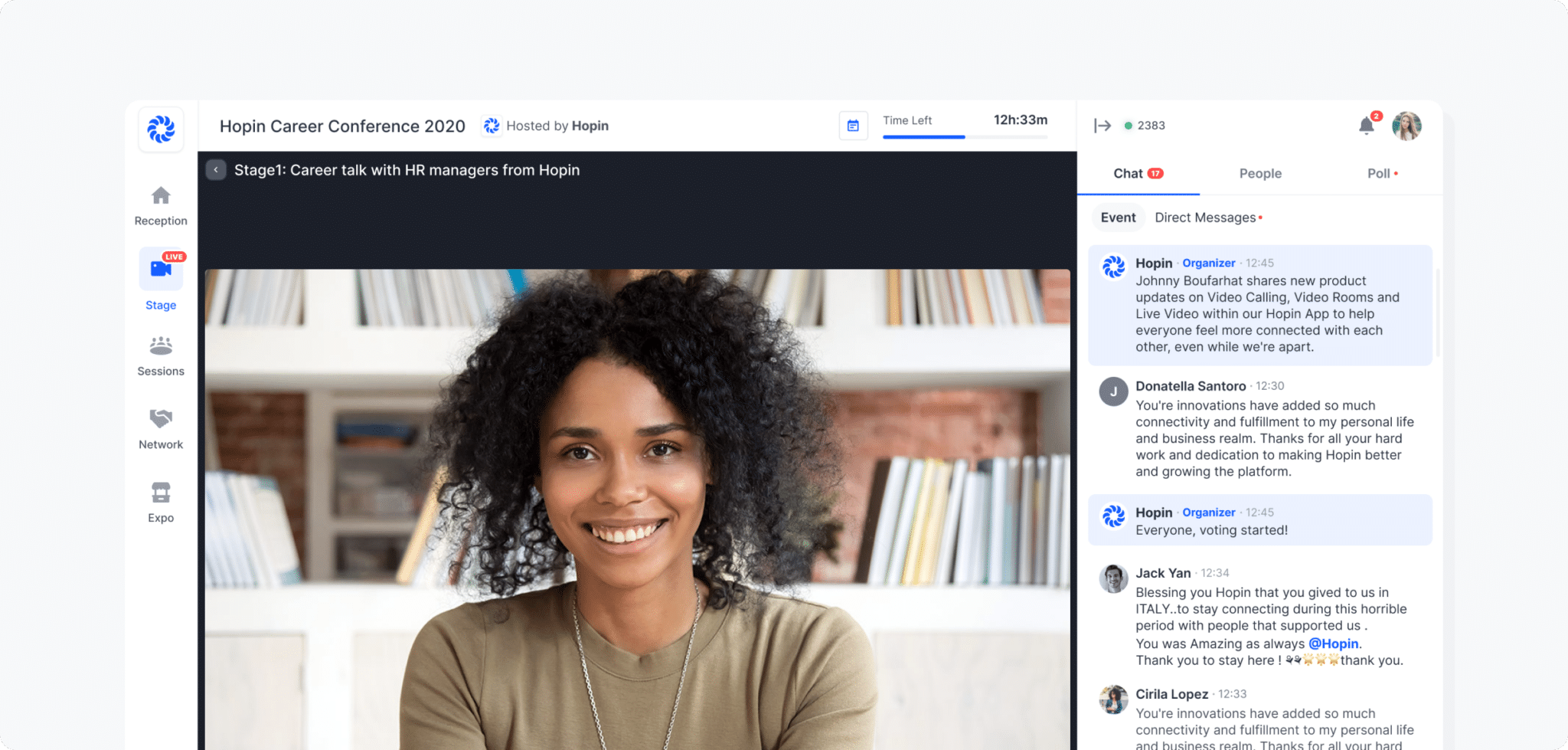
5. Invite high-profile leaders to present
One of the highlights of large conferences is the chance to hear—and maybe meet—high-profile industry leaders. Luckily, that draw is easy to recreate in a digital format by inviting leading industry professionals to present.
Attendees who follow those leaders are more likely to attend to hear what their favorite industry professional has to say.
And, because you won’t have to cover transportation and accommodation costs, you can likely land busy, in-demand speakers at a much lower rate.
6. Host panel discussions
Panel discussions bring together two or more experts to discuss and analyze a specific topic. They can be more engaging than single-person presentations, as the back-and-forth, in-the-moment conversations (and sometimes jokes) tend to be interesting to folks on the other side of the screen.
If you have more than two panelists, consider designating a moderator to help keep the conversation flowing. They can be in charge of fielding questions from the audience, bringing audience members on screen, and asking questions from the audience chat. Here’s a screenshot from an event that Knotch and Salesforce hosted on RingCentral Events featuring Gwyneth Paltrow, Marc Benioff, and Ambassador Susan Rice.
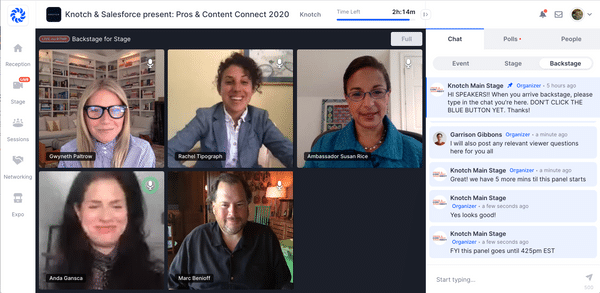
7. Make it interactive
One of the biggest challenges of hosting a virtual event has historically been being able to meet other attendees. How do you build a relationship with people when you can’t make direct eye contact, bump into them on the way to the happy hour, or ask in-person questions?
Many platforms have limitations here. With RingCentral Events, you can host virtual events without limits. As you can see from the examples above and below, there are multiple ways to connect with and engage attendees.
For example, the University of Notre Dame successfully took their football stadium virtual. They took watching football to a new level, introducing exciting elements to delight Fighting Irish fans.
It doesn’t stop there. You can have a happy wedding on RingCentral Events, enjoy yoga sessions at a beauty pop up event, host a fundraising event or even watch Dave Cremin, worldwide magician, perform magic.
Looking for even more ideas? Take a look at some innovative virtual events from around the world, and these 14 virtual event ideas and use cases.
Video conferencing tools vs. virtual event platforms
Video conferencing tools can work well for smaller groups. If you’re hosting a one-on-one or small-team meeting, these platforms are effective.
But video conferencing platforms do have limited functionality and they are focused on efficiency. They aren’t tailor-made for virtual events with highly interactive presentations or productions that require high-quality video streaming and large-scale setups.
When to use video conferencing tools:
- Small-group meetings
- One-on-one conversations
- Small-scale social gatherings
Virtual event platforms provide an all-in-one, branded event destination, including multiple virtual spaces for different types of content and interactions. These platforms take a physical event venue and shift the experience to an online format.
If you’re hosting a virtual event that stretches beyond a small group (and up to 100,000 attendees), you need a platform that supports that scale and has all the functionality you need. Virtual event platforms give you greater control over your content, audience experience, and branding.
Some valuable features of these platforms are:
- Multi-room virtual venues: Many different virtual spaces to accommodate a variety of content, programming, and attendee engagement.
- One-on-one networking: Video networking capabilities that allow participants to make one-on-one connections separately within the context of a larger event.
- Branding options: Virtual conference platforms give you the flexibility to create a high-quality look and feel for your event. Your online venue can also serve to immerse attendees in your brand. Take a look at how The Atlantic Festival exposed attendees to their brand during a virtual event.
- Interactive features: With features built to drive engagement, your online audience can easily ask questions or participate in sessions in multiple ways. The event experience can feature live Q&A sessions, interactive polls, collaboration functionality, games, and more. These elements are designed to make online participants part of the experience, not just spectators. It’s what distinguishes a virtual event from watching a live stream.
- Live video production tools: Advanced platforms and integrations like RingCentral Events and StreamYard give you the ability to elevate the production value of your live video content right within the platform. You can add professional touches like lower-third graphics, on-screen CTAs, a variety of split-screens, screen-sharing ability, and more—details that make your virtual event polished.
- Event analytics and data: Virtual event platforms give you a deep, cohesive view of audience data.
This comprehensive data includes:
- Registrations
- Attendee data
- Expo booth data, including Expo visitors and leads
- Ticket sales
- Average time spent in the event
- Total comments and chat transcripts
- Stage visitors
- Session visitors
- Networking participants
- Number of connections made
- Average user rating (NPS) and feedback
- Poll data
Conclusion
Your event audience has found new ways to connect, and they’re ready to maintain digital experiences as part of their lives. And now you’re equipped to create an impactful virtual event from anywhere.
The best virtual events find ways to smartly mirror the in-person experience by providing engaging and uniquely interactive content and networking opportunities. There is a whole world of creativity we’ve only started to explore.
We hope the few examples of virtual events in this article gave you a little inspiration for your next event—be it for yogis, poker players, magicians, developers, musicians, chefs, startups, team members, or anyone else!
Updated Mar 13, 2025









